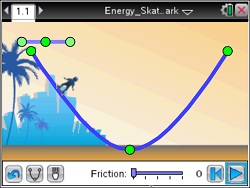Energy Skate Park (MG)

Energy Skate Park (MG)
In this lesson, students will use a simulation to manipulate several variables that impact the way a skateboarder moves on a track.
- Students will observe how variations in the dips and inclines of a skateboard track affect a skateboarder's motion.
- Students will analyze the affects of gravity and friction on the motion of the skateboarder.
- Students will apply knowledge of potential and kinetic energy to designing their own tracks.
- gravity
- potential energy
- kinetic energy
- friction
- speed
- force
- energy system
Adapted from a PhET™ simulation, this lesson involves students using TI-Nspire technology to simulate, observe and manipulate some variables that affect the way a skateboarder moves on a track.
As a result, students will:
- Reinforce understanding of how gravity and friction affect motion within a system.
- Understand that an object has potential energy due to its position above the surface of a body in the universe.
- Understand that kinetic energy is energy due to motion relative to a system.
- Recognize that potential energy can be transformed to kinetic energy and how this is related to the motion of a skateboard.
- Infer that some kinetic energy will be transformed to thermal energy due to friction.
Vernier EasyData,Vernier EasyLink and Vernier EasyTemp are registered trademarks of Vernier Science Education.

